Frankie Dettori, the legendary jockey, has been hailed as the 'best of all time' after surpassing the £150,000-a-week earnings mark in the USA. Since his surprise retirement U-turn last October, the 53-year-old has been riding exceptionally well in Santa Anita, California.
Impressive earnings in just over three weeks
After starting full-time competition in the States on Boxing Day, Dettori has already earned more than £450,000 in prize money. His latest significant victory came with outsider Honey Pants in the Grade 3 Las Cienegas Stakes last Sunday night.
'He is the best of all time'
Trainer Philip D'Amato was full of praise for Dettori, calling him 'the best of all time.' D'Amato commended Dettori's ability to position horses correctly and consistently deliver results.
A wise decision to move to the States
Although financially secure, Dettori's move to the USA appears to be paying off. He is enjoying the more relaxed racing atmosphere and has a strong chance of achieving his dream of winning the Kentucky Derby.
Still connected to the UK
While Dettori has embraced his new racing venture, he hasn't completely severed ties with the UK. He recently rode a winner for an English trainer who has broken rules 527 times in the past. Dettori also shared an embarrassing moment involving the late Queen during an interview with Piers Morgan.
Remember to gamble responsibly
Frequently Asked Questions
What is the initial step to training a racing horse?
The first phase of training a racing horse involves “breaking”, where the horse gets used to wearing a saddle and bridle as well as the weight of the rider. During these sessions, patience is key to ensuring the horse feels comfortable around humans and with the equipment they will use throughout their racing career.
What precautions should be taken to ensure the health of a racehorse when training it?
To prevent injury or illness, racehorses need to be given the attention they deserve. It is important to have regular veterinary exams, receive vaccinations, provide dental care, and maintain proper hoof health. The horse should also be monitored for signs of discomfort, fatigue or strain. The risk of musculoskeletal damage can be minimized by implementing a progressive training regimen.
Can you train a racehorse on any track?
While initial training can occur on a variety of tracks, specific race training often requires facilities that simulate the conditions the horse will face in competition. It is important to use tracks that are the same size as the actual track the horse will be racing on. By using the right track, you can condition your horse properly and help them get used to the racing environment.
How often is it recommended that racehorses are trained?
Racehorses are trained according to their individual needs, fitness levels, and race schedule. Typically, they would have a daily routine consisting of exercise such as walking, trotting, and cantering, with more exertive work such as galloping or breezing several times a week to build stamina and speed. Rest days are equally important to allow the horse to recover and prevent overtraining.
How can you ensure the mental wellbeing of your racehorse?
Mental health is just as vital to a horse’s performance as physical conditioning. The psychological health of racehorses is influenced by a variety of routines, regular turnout in pastures, mental stimulation and patient, gentle handling. Preventing stress and behavioral issues can be prevented by ensuring that the horse has regular social interactions with other animals and a calm, stable atmosphere.
What is a trainer’s role in training a racing horse?
Jockeys play an essential role in training racehorses. The jockeys ride the horses, giving feedback on their performance. They also help to educate the horse in racing tactics, like pacing the horse, positioning it, and responding when given commands. A good jockey will become familiar with the horse’s strengths as well as its weaknesses. This is vital for race preparation.
Statistics
- Approximately 70% of a racehorse’s diet consists of forage, with the remainder made up of grains and supplements to meet their high-calorie needs.
- Around 80% of thoroughbred racehorses begin their racing careers by the age of two, according to industry estimates.
- Statistically, less than 1% of thoroughbred foals born each year will go on to win a stakes race.
- Research has found that a racehorse’s stride length can increase by up to 7% following specific strength and conditioning programs.
- Studies suggest that proper early training can reduce the risk of musculoskeletal injuries in racehorses by up to 50%.
- Racehorse mortality rates during racing have been observed to be between 1.5 to 2 deaths per thousand starts, depending on the racing jurisdiction.
External Links
racingpost.com
grayson-jockeyclub.org
keeneland.com
jockeyclub.com
paulickreport.com
britishhorseracing.com
- British Horse Racing Authority – Training Racehorses
How To
How to Improve a Racehorse’s Stamina & Speed
Interval training helps racehorses improve their stamina and accelerate. This involves alternate periods of fast gallops with slower, recovery phases. Gradually increasing the distance of each workout as the horse gains fitness. Monitoring the horse’s recovery heartrate is essential in order to prevent them from being overexerted. It is also important to allow ample time for rest between training sessions.

